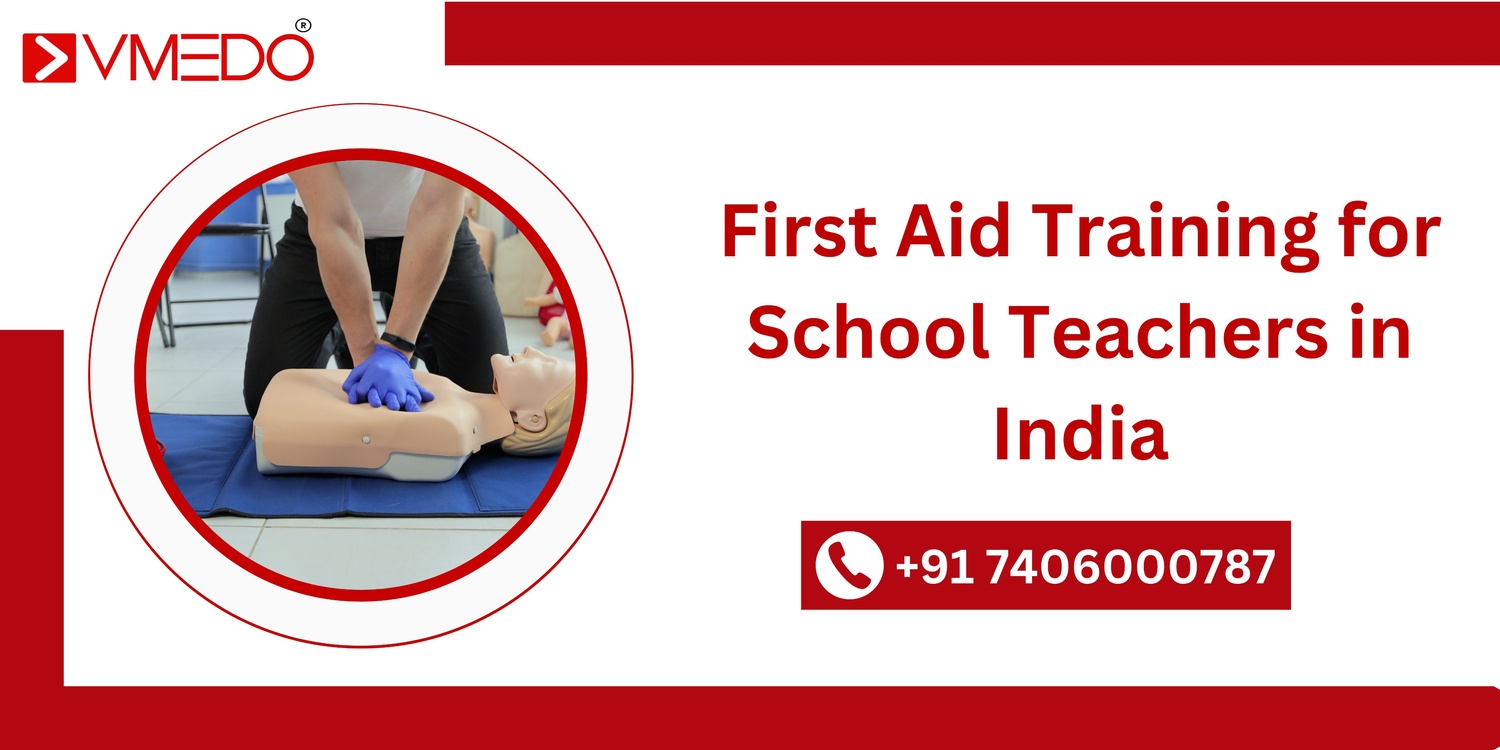In today’s fast-paced world, schools are not just places of academic learning but environments where the well-being of children is a top priority. At VMEDO, we recognize that while teachers shape young minds, they also bear the crucial responsibility of ensuring students’ physical safety. Our specialized first aid training equips educators with essential life-saving skills, empowering them to respond swiftly and effectively in emergencies. Partnering with VMEDO allows schools to create a safer environment for students, where their well-being is given the same priority as their education.
Don’t wait for an emergency to occur—empower your teachers with crucial first-aid skills. Contact VMEDO at +91 7406000787 or visit our website VMEDO today to schedule a training session and make your school a safer place for every child!
Why Is First Aid Training Important for School Teachers?
- Immediate Response to Emergencies
Schools are bustling environments where accidents can happen at times. From minor cuts and bruises to severe injuries like fractures, or life-threatening incidents like choking or cardiac arrest, teachers need to be prepared to handle emergencies before professional medical help arrives. First aid training enables them to respond quickly and appropriately, reducing the severity of the injury and potentially saving lives. - Creating a Safe School Environment
First aid-trained teachers help create a safer environment for students. Knowing how to assess risks, prevent accidents, and administer proper care can significantly reduce the chances of an injury worsening. This training empowers teachers to handle common school-related incidents such as playground injuries, nosebleeds, fainting, and even severe allergic reactions. - Mental Preparedness and Confidence
A trained teacher is not only equipped with practical skills but is also mentally prepared to remain calm under pressure. This preparedness fosters confidence, ensuring that teachers can take charge during emergencies and provide the necessary care. The ability to act decisively and without panic is crucial, especially when dealing with young children who may be frightened or confused during emergencies.
Key Components of First Aid Training for Teachers
At VMEDO, we design our first aid training programs with a focus on practical, easy-to-understand techniques that are specifically tailored for the school environment. Here are some essential components covered in our training:
- CPR and AED (Automated External Defibrillator) Training
One of the most critical life-saving techniques, Cardiopulmonary Resuscitation (CPR), is taught in detail. Teachers are also trained to use AEDs, which can help restart a child’s heart during a sudden cardiac arrest. - Dealing with Choking and Breathing Difficulties
Choking is a common emergency, especially in young children. Our training covers the Heimlich maneuver and other techniques to clear blocked airways. - Managing Bleeding and Wounds
From small cuts to serious bleeding, teachers learn how to properly clean, dress, and manage wounds to prevent infection and further injury. - Handling Fractures and Sprains
Falls and playground injuries can often result in fractures or sprains. Our training focuses on immobilizing the injured area and reducing pain until medical help arrives. - Responding to Allergic Reactions and Asthma Attacks
With rising cases of allergies and asthma among children, teachers are trained to recognize symptoms and use epinephrine auto-injectors (EpiPens) and inhalers when necessary. - Basic Life Support (BLS)
Teachers also learn basic life support techniques, which include performing chest compressions and rescue breathing to maintain blood flow and oxygen in an unresponsive child.
Common Emergencies Faced in Schools
Schools are dynamic environments where a wide range of emergencies can occur. While minor injuries are common, schools also face more serious incidents that require immediate attention. Here are some of the most common emergencies faced in schools:
1. Minor Cuts and Bruises
- Children often get cuts, scrapes, and bruises while playing, running, or during physical activities. These injuries, while not life-threatening, need proper cleaning and dressing to avoid infections.
2. Falls and Fractures
- Falls from playground equipment, stairs, or even slips in classrooms can result in sprains or fractures. Quick immobilization and first aid can help manage the injury until professional medical help arrives.
3. Choking
- Choking, especially in younger children, can happen during lunch or snack breaks. It’s essential for teachers to know how to respond to choking incidents using the Heimlich maneuver to clear airways.
4. Asthma Attacks
- Asthma is a common chronic condition in children. Schools often face emergencies where students may have difficulty breathing due to asthma attacks. Teachers trained in using inhalers or recognizing early signs of distress can help stabilize the child.
5. Allergic Reactions
- Food allergies, bee stings, or even exposure to certain chemicals can trigger allergic reactions, some of which can be life-threatening (anaphylaxis). Administering an EpiPen and calling for medical help immediately is crucial in such cases.
6. Nosebleeds
- Nosebleeds are relatively common in children and can be caused by trauma, dry air, or underlying conditions. Knowing how to stop a nosebleed by applying pressure and tilting the head forward can prevent unnecessary complications.
7. Heat Exhaustion and Dehydration
- During outdoor activities, sports days, or in hot weather, children are prone to heat exhaustion or dehydration. Recognizing early signs like excessive sweating, dizziness, or fainting can help prevent these conditions from worsening.
8. Fainting (Syncope)
- Fainting can be caused by dehydration, standing for long periods, or underlying health conditions. Teachers should know how to safely manage a child who has fainted and how to position them to recover properly.
9. Seizures
- Some students may have epilepsy or experience seizures due to other medical conditions. In such cases, teachers need to know how to keep the child safe during the episode by preventing injury and ensuring their airway remains clear.
10. Sudden Cardiac Arrest (SCA)
- Though rare in children, sudden cardiac arrest can occur due to congenital heart conditions or unknown issues. Knowing CPR and how to use an Automated External Defibrillator (AED) can be life-saving in such critical situations.
11. Head Injuries
- Accidents leading to head injuries, such as falls, collisions, or being hit by objects, can range from mild concussions to more severe trauma. Teachers should know how to assess the severity and provide appropriate first aid.
12. Burns
- Accidents in school labs, kitchens, or even during craft activities can lead to burns. Immediate cooling of the burn area and covering it with sterile material is key to providing first aid.
By being prepared and trained in handling these common school emergencies, teachers and school staff can ensure a safer environment for students, minimizing the impact of accidents and health issues.
What a Comprehensive First Aid Course Covers
A first aid training course designed for preschool teachers typically includes both theoretical and practical components. Here’s an overview of what a comprehensive course may cover:
|
Basic First Aid: 3 hours |
Advanced First Aid: 6 hours |
|
|
How VMEDO is Bridging the Gap
At VMEDO, we recognize the critical need for first aid training, especially for school teachers who work closely with vulnerable young children. Our training programs are designed to be comprehensive yet accessible, covering all the essential skills that teachers need to handle emergencies confidently.
Key Features of VMEDO’s First Aid Training:
- Tailored Programs for Educators: We focus on the types of emergencies most likely to occur in a preschool environment, such as choking, minor injuries, and allergic reactions.
- Hands-on Learning: Our training sessions are practical and interactive, allowing teachers to practice the skills they are learning.
- Certified Trainers: All our trainers are certified professionals with extensive experience in first aid and emergency care.
- Post-Training Support: We provide resources and continuous support to ensure that teachers feel prepared even after the training is over.
Our goal is to make first aid training a standard part of preschool education, ensuring that all teachers have the knowledge and confidence to keep their students safe.
Frequently Asked Questions About First Aid Training for School Teachers
1. Why is first aid training necessary for school teachers?
First aid training is essential for school teachers because they are often the first to respond to accidents or medical emergencies that occur on school premises. At VMEDO, we provide specialized first aid training that equips teachers with critical life-saving skills, ensuring they can handle emergencies.
2. What kind of emergencies will the first aid training cover?
VMEDO’s first aid training covers a wide range of emergencies commonly faced in schools, such as choking, fractures, cuts, stroke, and even CPR for cardiac arrest. Our programs are specifically designed to address the unique needs of a school environment, ensuring teachers are well-prepared to handle emergencies of all kinds. With VMEDO, schools can become proactive in creating a safer environment for students.
3. How long does the first aid training take?
Our first aid training courses are flexible and can be tailored to fit your school’s schedule. Typically, a basic first-aid training session takes about 3 hours, and an advanced first-aid training session takes about 6 hours. By choosing VMEDO, you’ll not only ensure that your teachers are well-trained but also provide them with skills that will benefit the entire school community.
4. Do teachers receive certification after completing the first aid training?
Yes, VMEDO provides certification to all teachers who complete the first aid training. This certification not only acknowledges their preparedness but also helps your school meet safety standards. Certification from VMEDO reassures parents and stakeholders that your school prioritizes student safety and is committed to fostering a secure learning environment.
5. How often should first aid training be refreshed?
It’s recommended that first aid skills be refreshed every three years, as techniques and best practices can evolve. VMEDO offers refresher courses to ensure your teachers stay up-to-date with the latest in first aid care, keeping your school consistently prepared for any emergency.
6. What is the cost of first aid training for schools?
The cost of first aid training varies based on the number of participants and the specific requirements of the school. At VMEDO, we offer competitive pricing and customized packages to fit your budget while ensuring high-quality training. Our goal is to make first aid training accessible to every school, helping create safer environments without financial strain.



